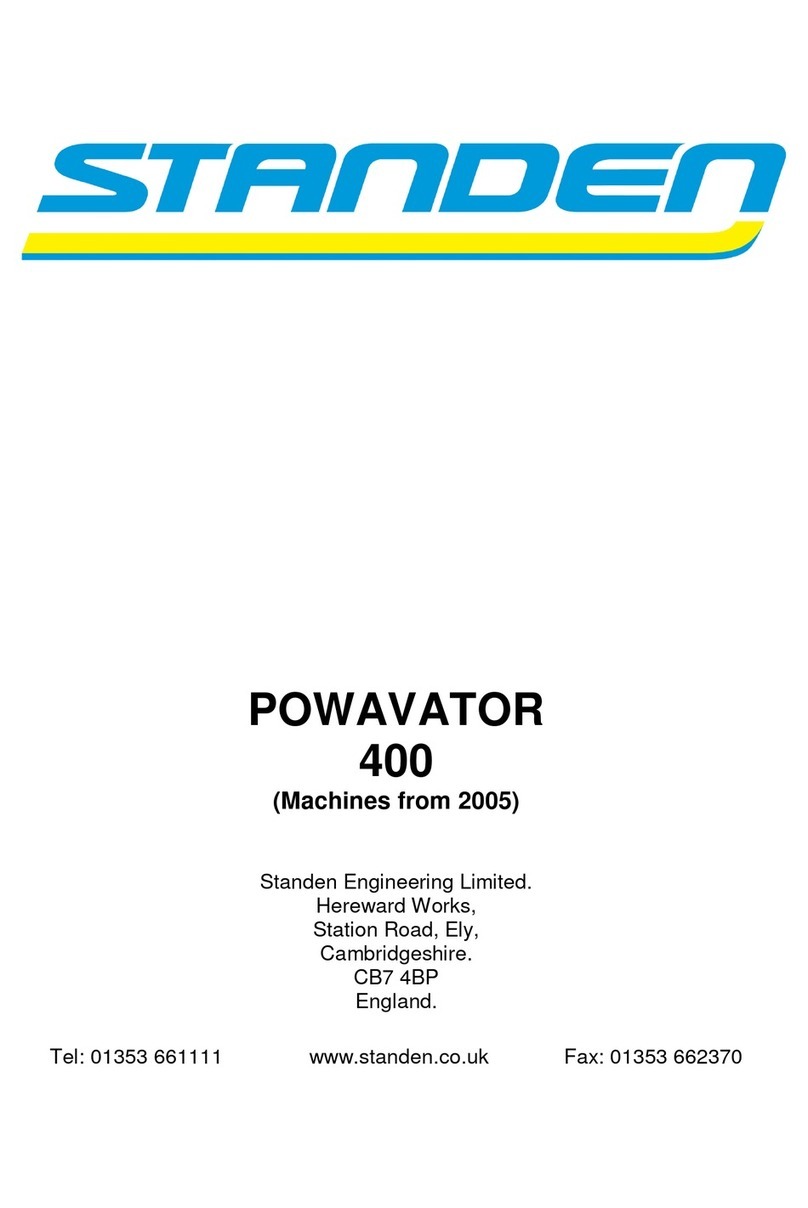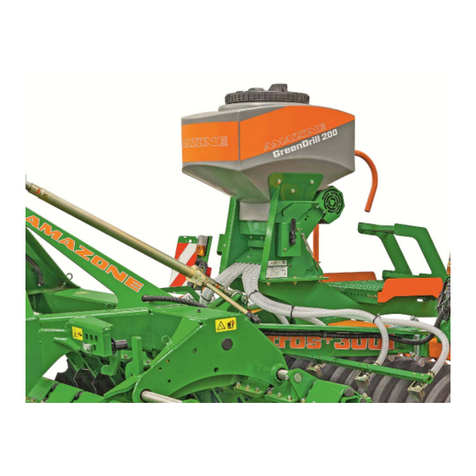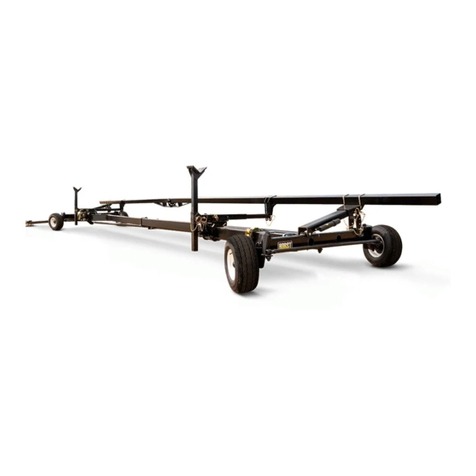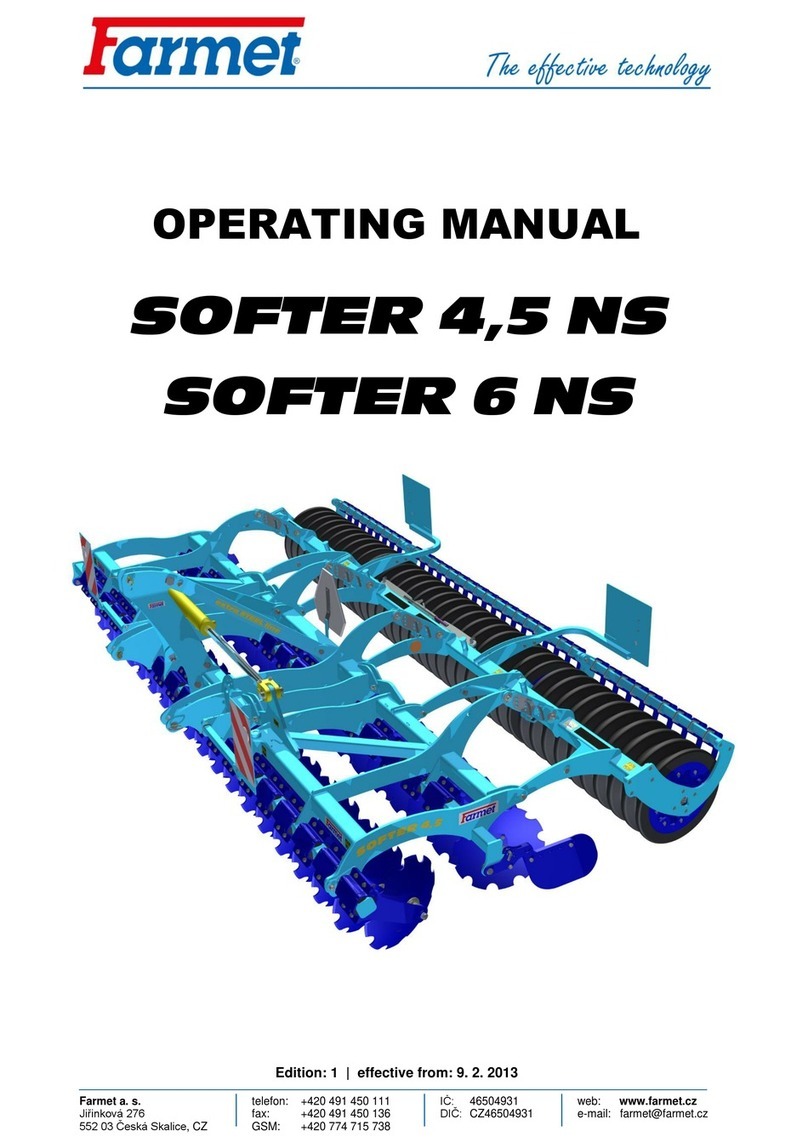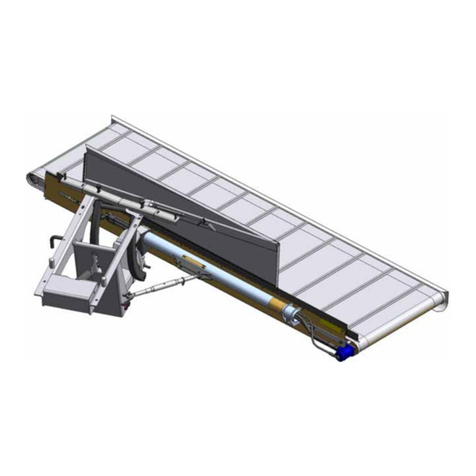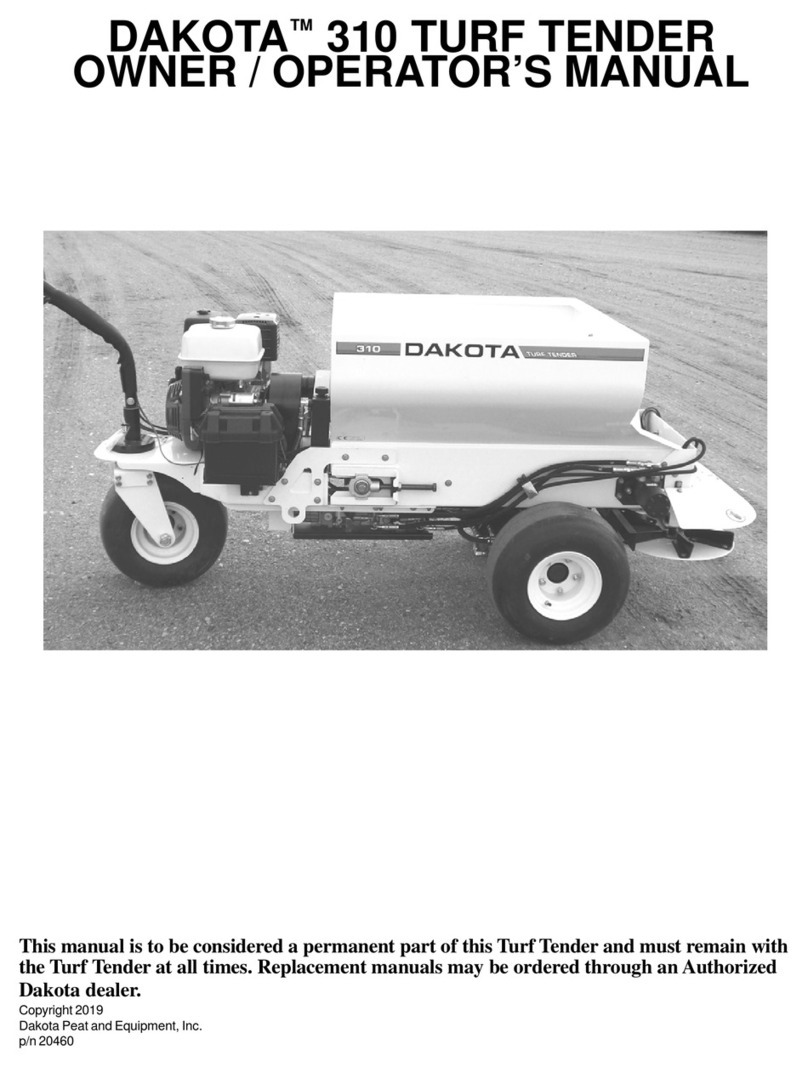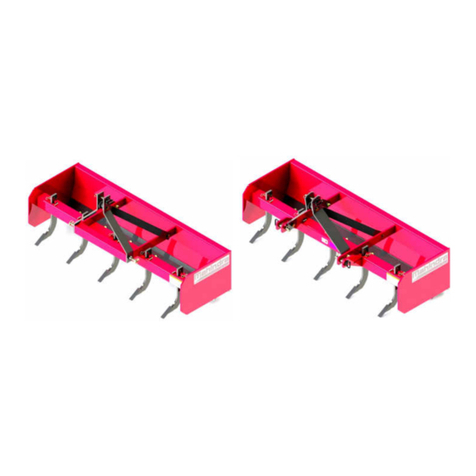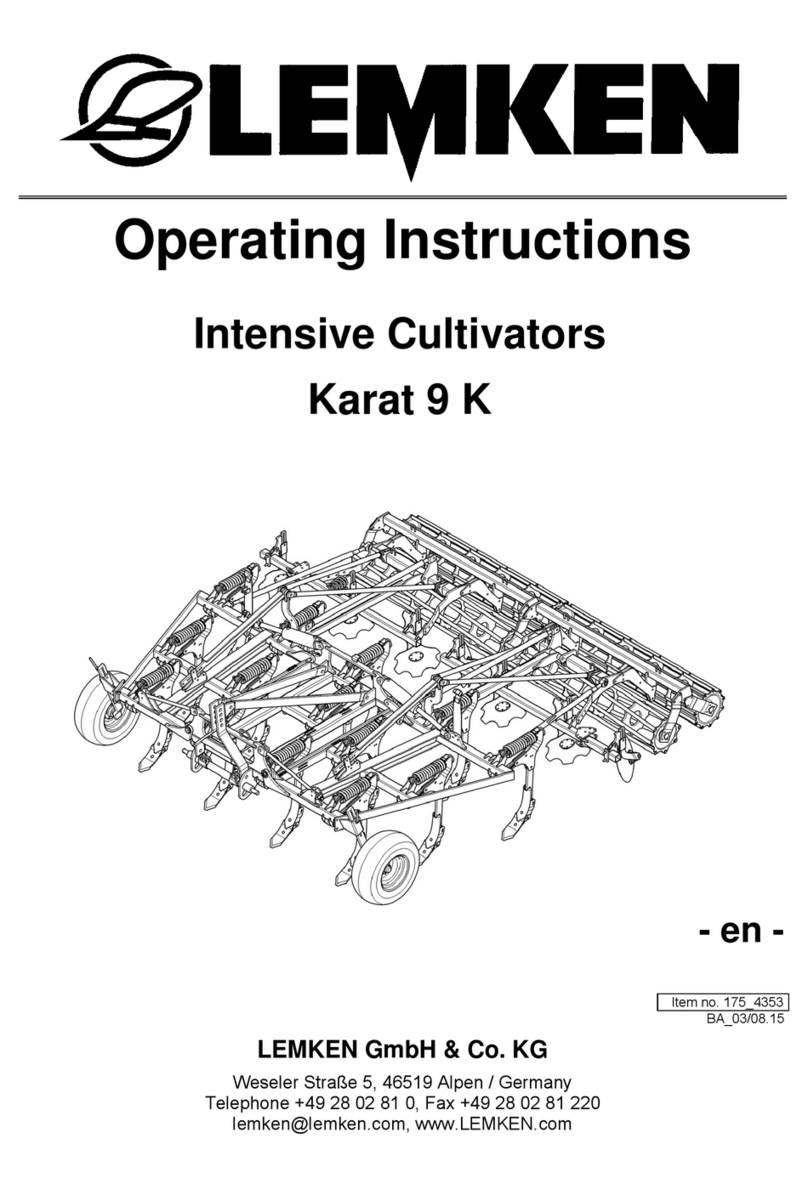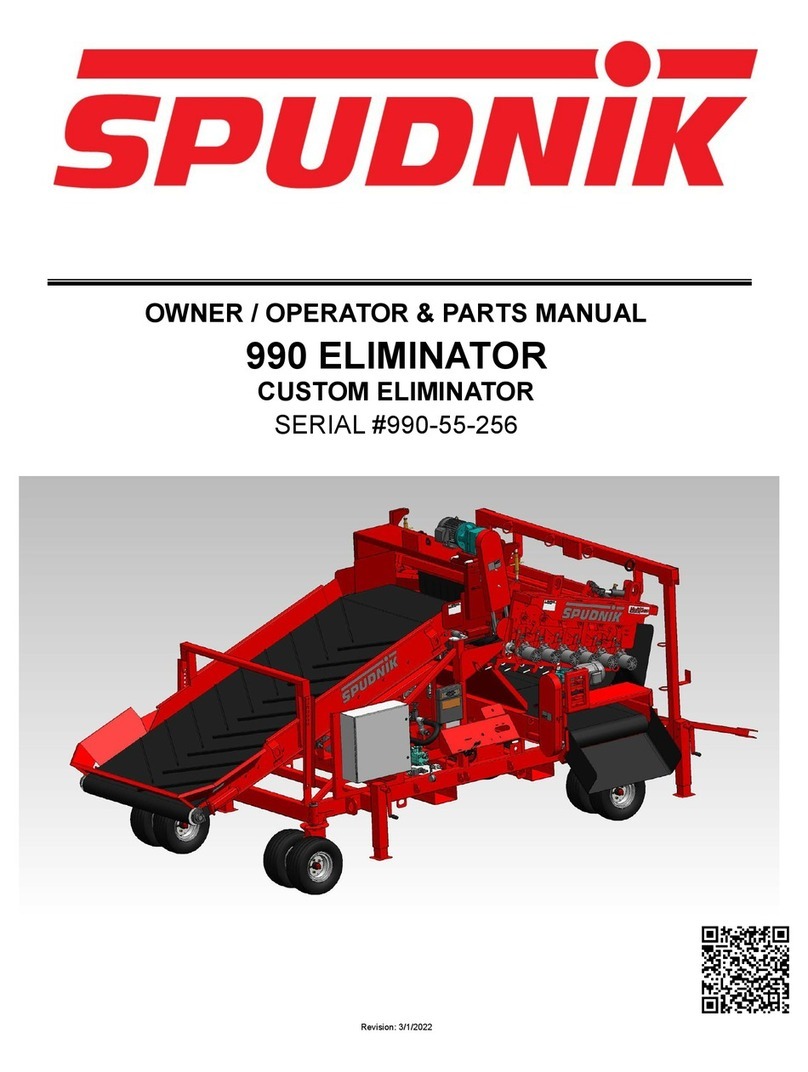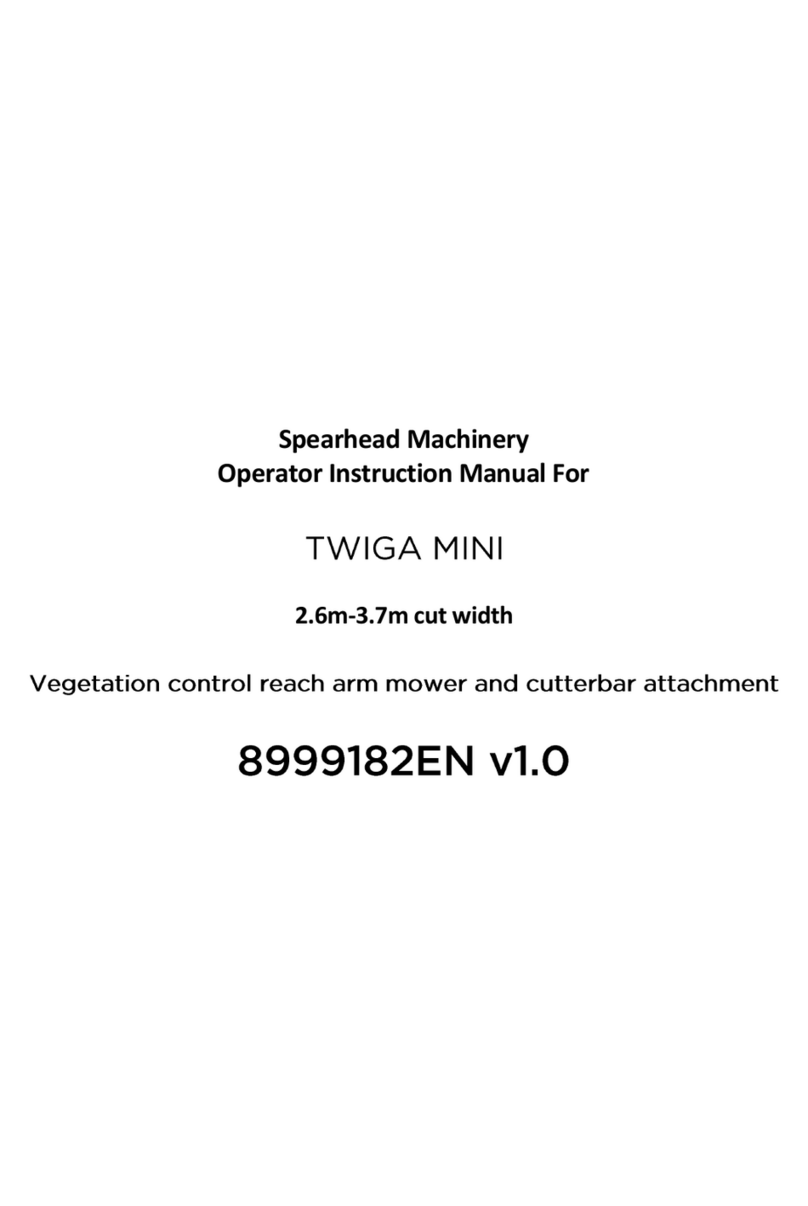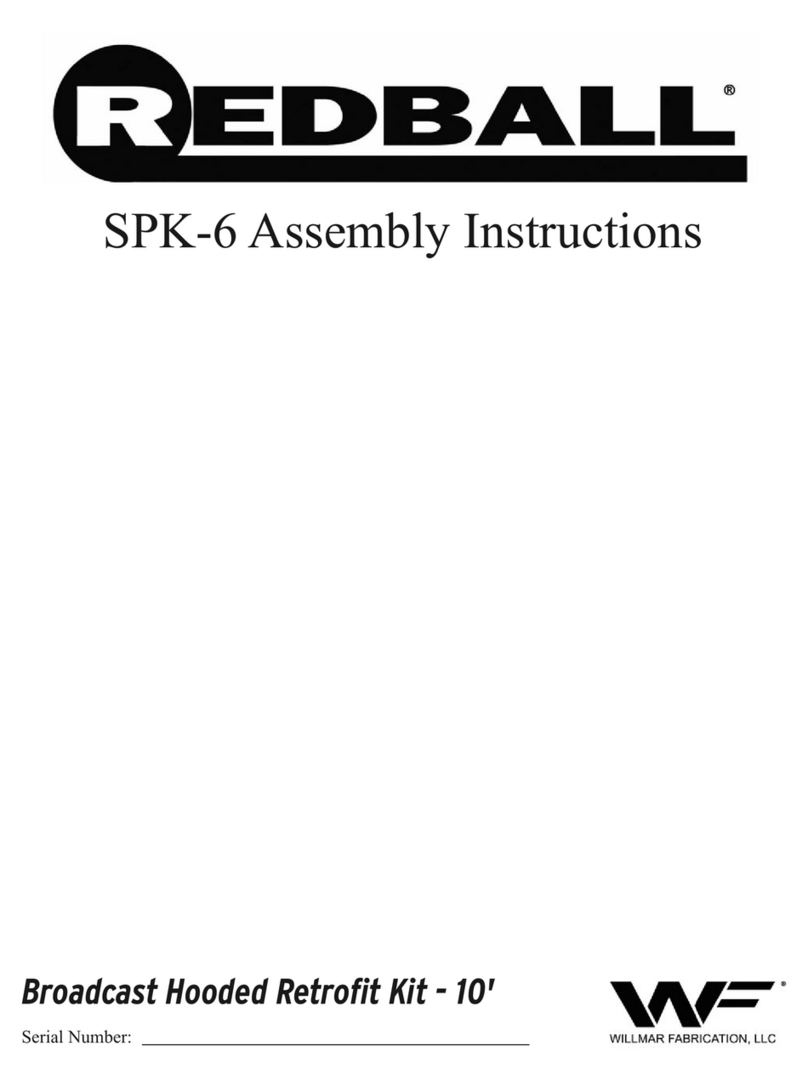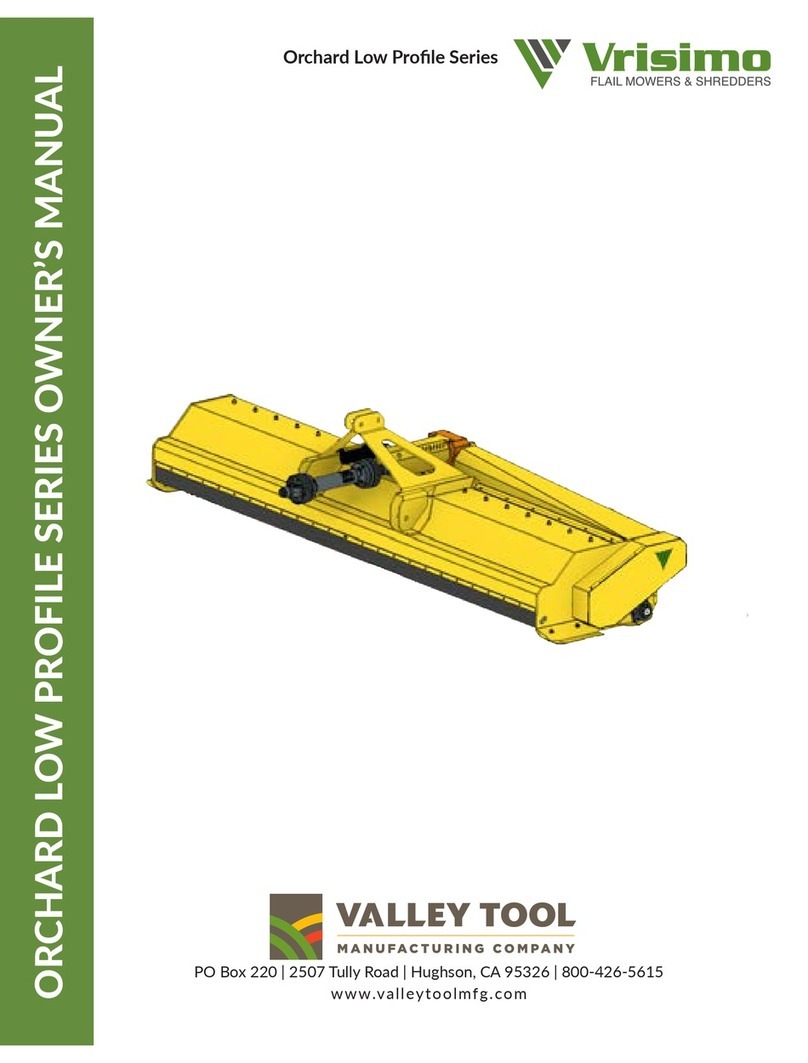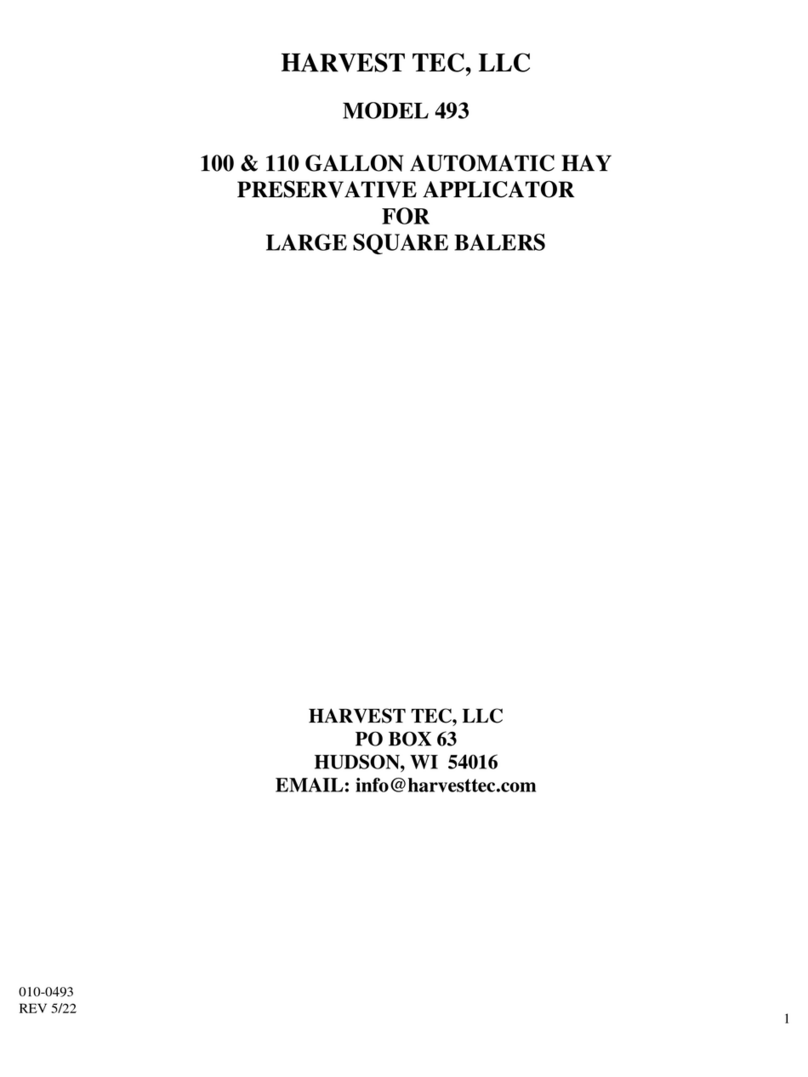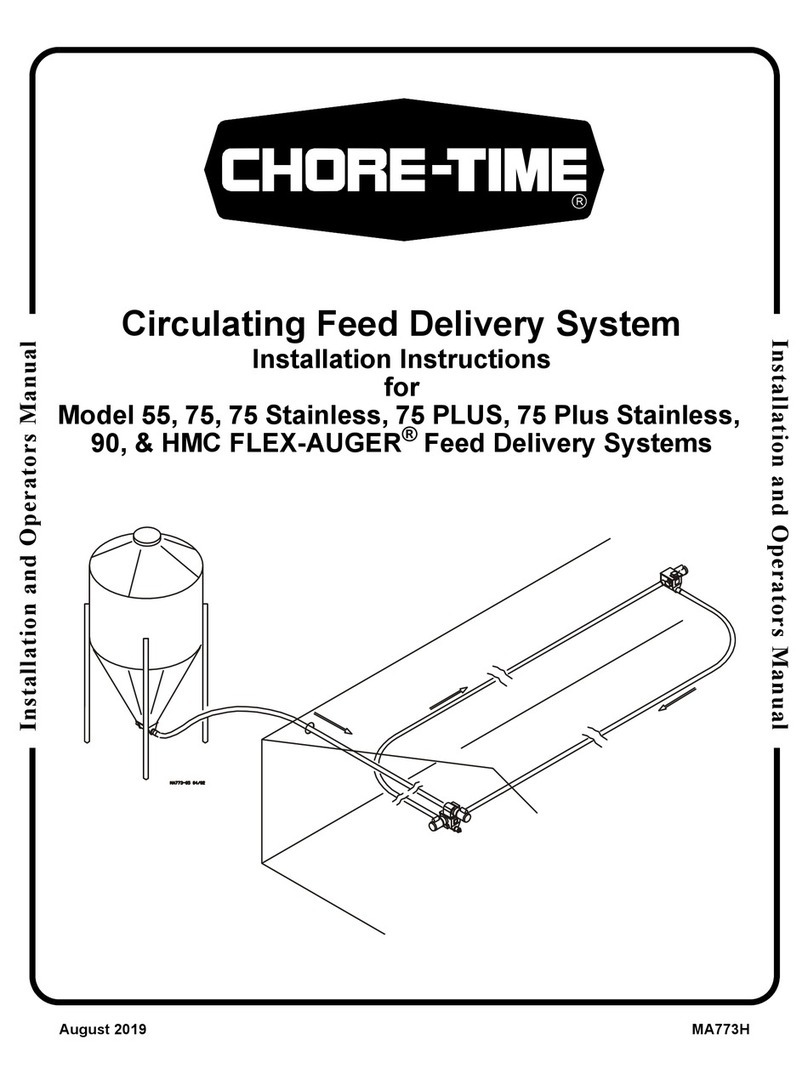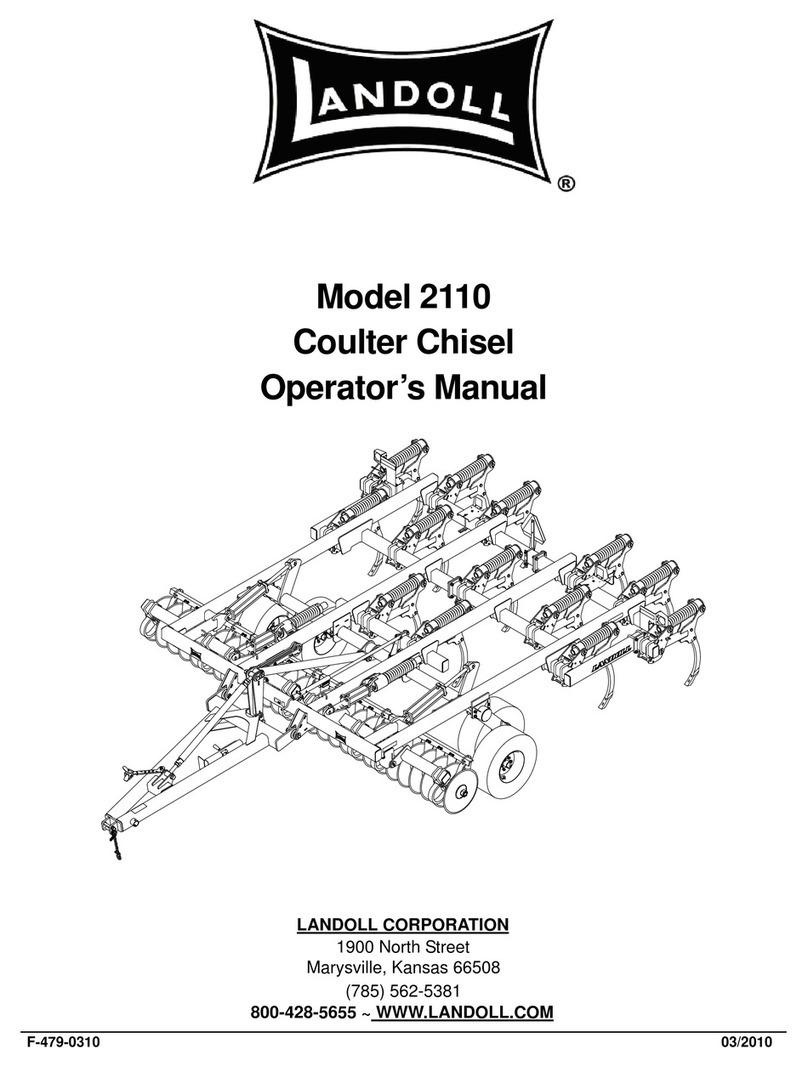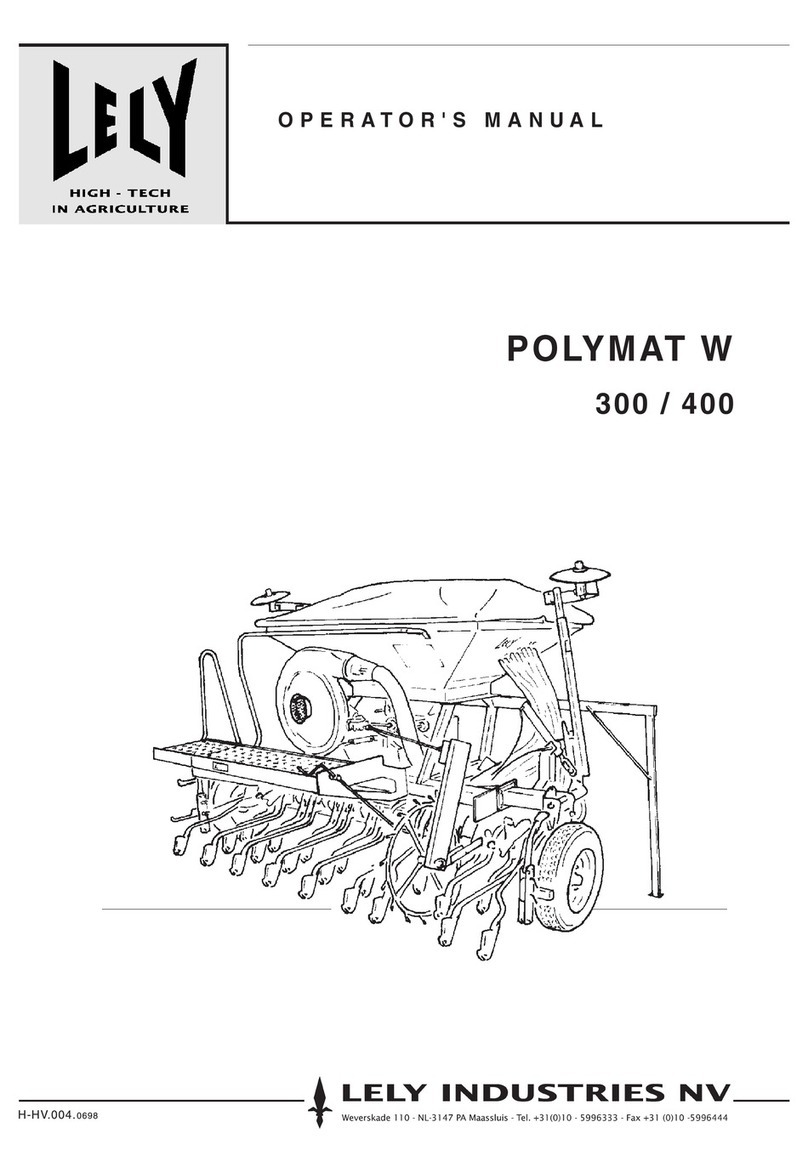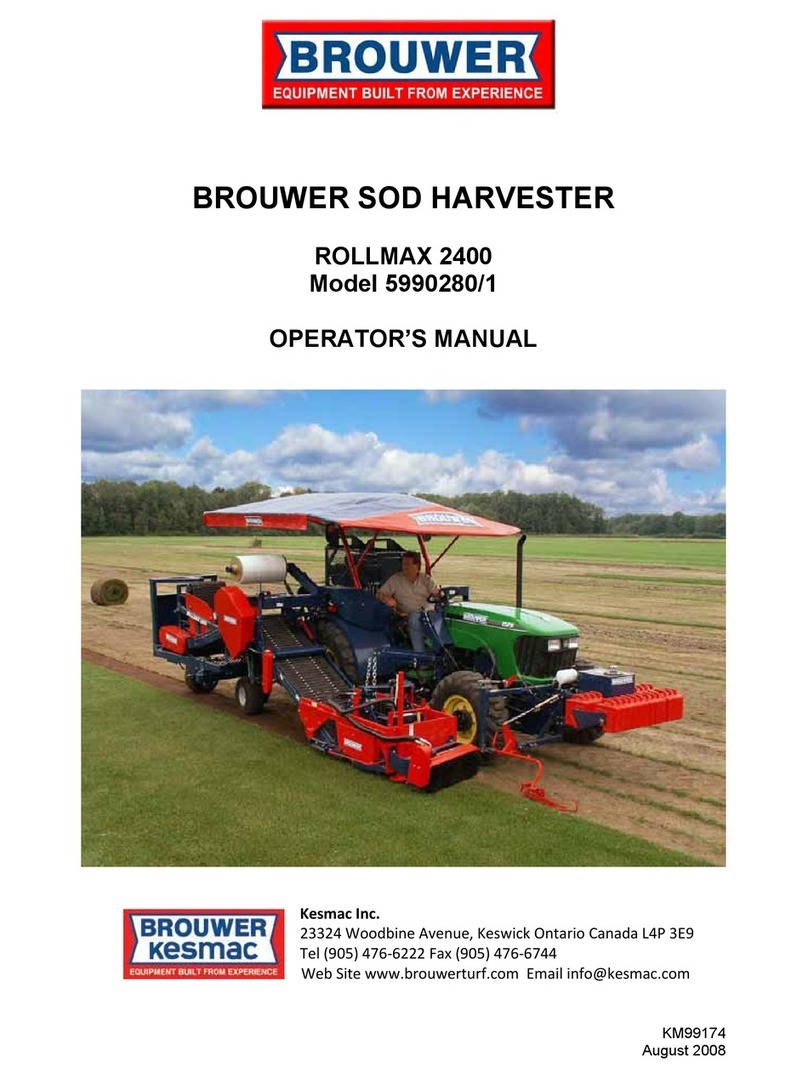Standen SP Series User manual

SP Series
3-Bed Rigid
Potato Planter
Standen Engineering Limited.
Hereward Works,
Station Road, Ely,
Cambridgeshire.
CB7 4BP
England.
Tel: 01353 661111 www.standen.co.uk Fax: 01353 662370


On delivery check that the machine is as ordered and has not been damaged in
transit. Please report any shortfall to your Standen dealer.
The contents of this handbook, although correct at the time of publication, may be
subject to alteration by the manufacturers without prior notice.
Standen Engineering Limited operates a policy of continual product development.
Therefore, some illustrations and/or text within this publication may differ from your
machine.
The copyright of this handbook is the property of Standen Engineering Limited,
Hereward Works, Station Road, Ely, Cambridgeshire. CB7 4BP. This handbook is
issued on the condition that it must not be used, copied or exhibited without their
written permission.
IMPORTANT
This operator’s handbook should be regarded as part of the
machine. Suppliers of both new and second-hand machines are
advised to retain documentary evidence that this handbook was
supplied along with the machine.
On installation of the machine (i.e. starting off in the field), the New
Machine Installation Record Card should be completed by the
dealer/distributor and be countersigned by the customer. The
document is proof that the correct procedures have been followed.
The New Machine Installation Record Card should be returned to
Standen Engineering Limited within 7 days of installation. Failure to
do so may invalidate the machine warranty.


INTRODUCTION
Introduction to the Handbook 1.1
Warranty 1.1
Replacement Parts 1.2
SAFETY PRECAUTIONS
Safety 1.3
INSTALLATION
Overview 1.5
Tractor Suitability 1.5
Preparing the Planter for Work 1.5
Preparing the Planter for Transport 1.6
OPERATION
Main Control Box Functions 1.7
Planting 1.8
Floating Openers 1.8
Soil Retention Panels 1.8
Adjustable Mould Board 1.9
Feed of Potatoes to Cups 1.10
Feed Belts 1.10
Cup Belts 1.11
Insert Cups 1.12
Seed Monitors 1.12
Cup Belt Agitators 1.13
Automatic Depth Control (prior to 2013) 1.13
Setting the Automatic Depth Control (prior to 2013) 1.14
Depth Control Sensor Adjustment (prior to 2013) 1.14
Hydraulic Space Selector 1.16
Calibrating the Control Box to the Flow Regulator Valve 1.16
Calibrating the Control Box Area Recorder 1.18
Hydraulic Space Selector in Operation 1.18
Seed Spacing 1.19
Planting Rate 1.19
Unload/Prime 1.19
Seed Population 1.19
Area Recorder 1.20
Proximity Sensor Adjustment 1.20
MAINTENANCE
Lubrication 1.21
Mechanical Drives Maintenance 1.21
Electrical System Maintenance 1.21
Hydraulic System Maintenance 1.21
Steering Ram Link Circuit 1.23
Daily Maintenance 1.24
Weekly Maintenance 1.24
Annual Maintenance 1.24
Out of Season Storage 1.25
SPECIFICATION
Machine Dimensions 1.26
Machine Weight 1.26
Technical Data 1.26
SEED POPULATION TABLES
2 Row & 2 Cup Quad Seed Population 1.27
4 Cup Quad Seed Population 1.28
APPENDIX
Automatic Depth Control (from 2013) 1.30
Setting the Automatic Depth Control (from 2013) 1.30
Depth Control Sensor Adjustment (from 2013) 1.32
CONTENTS

Introduction to the Handbook
This handbook provides the information for the operation, adjustment and
maintenance of your Standen SP Series 3-Bed Potato Planter. To enable you to
achieve the best results from the machine, the manufacturer recommends that you
read the handbook thoroughly prior to using the machine for the first time.
Record below the details of your machine.
Dealers name...............................................................................…………….
Address......................................................................................................
.................................................................................................................
Telephone number.................................................................................…….
Machine serial number...............................................................................…
Date purchased............................................................................................
Date started work........................................................................................
This symbol indicates important safety messages within this handbook.
When you see this symbol, be alert to the possibility of injury to yourself
or others and/or damage to the machine and carefully read the
message that follows.
Throughout this handbook the terms 'front', 'rear', 'left-hand' (LH) and 'right-hand'
(RH) are derived from the tractor driver’s position facing forward in the normal
direction of travel.
Adjustments to the machine may have to be made singly or in combination according
soil conditions. Always allow the machine to settle to a new setting before making
further adjustments.
Recommended lubrication and maintenance instructions are included in this
handbook and if followed will help to keep the machine in a safe working condition.
Warranty
Should the machine suffer any faults or defects within the warranty period, please
contact your dealer. The warranty shall be effective only if the dealer is informed of
any such defect as soon as practicable upon discovery.
1.1
INTRODUCTION

Replacement Parts
Recommended replacement parts are designed for your machine and have the full
backing of the warranty. Only when recommended parts are used can responsibility
be considered under the terms of the warranty.
The rear section of this handbook contains lists of spare parts available through your
Standen Agents. Each illustration shows a complete unit or assembly in exploded
form. Standen's policy of continual product development means that components or
even complete assemblies are redesigned from time to time. Where possible the
modifications are shown in the remarks column.
The first printing of each page in the spare parts section is identified as issue 1 at the
foot of the page. When a complete unit or assembly has been redesigned the
appropriate pages are revised and printed as issue 2. The revised pages are filed
behind the existing issue so that a complete modification history is gradually built up.
When using an illustration and parts list it is essential that both are of the same issue.
Always quote the full serial number of your machine when ordering spare
parts.
INTRODUCTION
1.2

Safety
The Standen SP Series Potato Planters have been designed to comply with current
Safety Regulations. However, as with all machinery there will be inherent dangers
whilst operating and carrying out maintenance on the machine. The following list of
precautions should therefore be brought to the attention of all persons operating and
working on the machine. The list is not exhaustive. All machinery is potentially
dangerous and great care must be exercised by the operators at all times. Standen
Engineering Limited will not accept liability for damage or injury caused by their
products except when such liability is specifically imposed by English statute.
The machine must never be operated by untrained personnel or
children.
The tractor must be of a suitable size to lift the implement safely. This
may entail the fitting of front weights to counterbalance the machine.
Always check that the machine has been correctly mounted to the
tractor before setting off on operations and the stabilizers are correctly
set.
Never set machinery in motion before ensuring that everyone in the
vicinity is aware of your intentions.
Never allow children or animals in the vicinity where machines are
working and never allow anyone to ride on the machine.
Never attempt to fit drive chains or drive belts to the machine while the
drive sprockets or pulleys are in motion.
Normal safe working procedures should be adopted at all times.
Reduce speed when transporting the machine on sloping ground.
Do not work on ground where there is a possibility of overturning or
across steep slopes.
The working area should be kept clear and free of obstructions at all
times. Be alert for hidden obstructions. Should the machine hit an
obstruction, stop and check for damage before proceeding.
Wear substantial or proper safety footwear. Avoid loose clothing near
moving parts. Wear gloves when handling the implement or parts with
sharp edges.
Before carrying out any work on the machine, lower the machine to the
ground, switch off the tractor engine, apply the handbrake, remove the
ignition key. Never work on or pass under the machine when it is raised
on the tractor hydraulic linkage.
1.3
SAFETY PRECAUTIONS

When left free standing i.e. not attached to the tractor, the machine
must be on level ground.
The operator must not leave the tractor seat until the machine has been
lowered to the ground, the tractor engine switched off, the handbrake
applied and the ignition key removed.
Never stand on the platform whilst the machine is operating.
All guards, covers, warning transfers and safety devices must be
correctly fitted and operable at all times.
Inspect the machine on a regular basis and replace damaged or worn
parts as necessary. Inspect the machine for damage after use. Never
operate the machine in a state of disrepair.
When in transport keep the hopper empty. Always fill the hopper in the
field. Transporting with a full hopper will cause strain on the planter and
will pack the potatoes in the hopper causing ‘bridging’ when planting
commences.
When in transport the hopper and moulding boards must be fully raised.
When locking the mould boards into the transport position, never walk
under the raised board, always approach from the side.
Only transport the machine at a speed suitable to the prevailing
conditions. Be aware of the weight and overall length of the machine at
all times.
Care must be taken when carrying out any work on the hydraulic
system. Even when stopped and disconnected from the tractor, residual
pressure will exist within the hydraulic system. Therefore, before
commencing any work on the hydraulics ensure that the system is free
of residual pressure. Regularly check hydraulic hoses for chafing or
damage and replace as necessary.
Safety is the responsibility of the persons working with this
machine. Think "safety" at all times. Read and remember the
contents of this handbook.
SAFETY PRECAUTIONS
1.4

Overview
The SP Series 3-Bed Potato Planter is designed to be towed from the tractor pick-up
hitch. The machine plants potatoes with extreme gentleness and accuracy. Seed
spacing, planting depth and soil covering are all controlled for optimum results.
Gentle seed handling is ensured by a controlled seed flow to the cups. Each moving
floor belt is only activated when the seed is required. Independent automatic depth
control is provided for each pair of openers enabling accurate planting depth to be
maintained on uneven land.
Tractor Suitability
The SP Series 3-Bed Planter is suitable for tractors of 118 kW (160 hp) minimum.
The tractor must be of a suitable size to lift the implement safely. This
may entail the fitting of front weights to counterbalance the machine.
When fitting to the tractor ensure the planter is standing on firm level
ground. The operator should have read and understood the tractor
operators manual prior to attaching the machine and putting into work.
Preparing the Planter for Work
1. Set the drawbar into its work position by removing the short locking pin and
securing it with the stay pin.
2. Reverse the tractor up to the planter and engage the drawbar eye on the
tractor pick-up hitch. If necessary adjust the height of the drawbar eye using a
different set of holes.
3. Raise the planter on the pick-up hitch.
4. Raise the parking stands (item 1, fig 1) and secure with the locking pins.
5. Connect the hydraulic pressure hose (marked red) to the tractor constant
supply port. Connect the return hose (marked blue) to the tractor return port.
6. Mount the control boxes securely inside the tractor cab in a position where
they are comfortable to operate when seated.
7. Connect the cables between the planter and control boxes ensuring they are
safely and securely routed in the tractor cab. The control boxes require a 12v
D.C. supply. Connect the power leads to the tractor electrical plug (if fitted) or
directly to the tractor battery, blue lead to negative (-) terminal and brown lead
to positive (+) terminal.
8. Remove the mouldboard transport pins (item 1, fig 2) and refit them into the
hole (item 2, fig 2) to support the adjustable link (item 3, fig 2).
The parking stands (item 1, fig 1) must be raised before commencing
work. When disconnecting the planter from the tractor always ensure
the stands are lowered to support the machine.
1.5
INSTALLATION

Preparing the Planter for Transport
1. Empty the hopper.
2. Lower the top frame fully using the switch marked ‘FRONT LIFT
RAISE/LOWER’.
2. Raise the rear section of the tipping hopper.
3. Raise the mould boards and secure them in the transport position with the
pins (item 1, fig 2).
A proximity sensor mounted under the rear of the tipping hopper
ensures that the hopper and mould boards do not come into contact
with each other at any time during folding. The sensing distance is
preset at the factory to 200mm and should not be tampered with.
When locking the mouldboards into the transport position, never walk
under the raised board, always approach from the side.
INSTALLATION
1.6
Fig 1 Fig 2

Main Control Box Functions
POWER ON/OFF: Power is ON when LED is illuminated.
FRONT LIFT RAISE/LOWER: Raises/lowers front of machine to lift openers in
and out of work.
AUTO-DEPTH ON/OFF: Automatically raises/lowers individual pairs of
openers to maintain planting depth in that bed.
Auto-depth circuit is ON when LED is illuminated.
OPENER RAISE/LOWER: The 3 switches override the automatic depth
control on rows indicated.
RH BED ON/OFF: Starts/stops RH pair of feed belts and cup belts.
CENTRE BED ON/OFF: Starts/stops centre pair of feed belts and cup belts.
LH BED ON/OFF: Starts/stops LH pair of feed belts and cup belts.
AGITATOR ON/OFF/SPEED: Cup belt agitators are ON when LED is illuminated.
Agitation increased/decreased by dials ‘ RH BED 1
& 2’, ‘CENTRE BED 3 & 4’ & ‘LH BED 5 & 6’.
SEED MONITOR : LEDs ‘ 1,2,3,4,5or 6’ illuminate when no potatoes
detected in that row. Dial sets time delay for all
seed monitors.
BUZZER ON/OFF: Sounds when no potatoes detected in one of the
rows.
ALL RUN ON/OFF: ON/OFF for all active drives, agitators and auto-
depth simultaneously.
AXLE RIGHT/LEFT/CENTRE: Steers the four land wheels in the direction
indicated. Centres the wheels after turning.
MOULDBOARD RAISE/LOWER: Raises/lowers mould boards at rear of planter.
HOPPER RAISE/LOWER: Raises/lowers rear section of hopper for filling.
1.7
OPERATION

Planting
Careful planting is one of the pre-requisites for a good crop of high quality potatoes.
The potatoes should be planted in straight ridges without gaps and at a correct and
even depth. This is achieved when, at the beginning of planting, the functions of the
planter and the different adjustments are carefully studied. The seed potatoes used
can vary a great deal (i.e. different varieties, shape, size, number of sprouts, skin
quality etc.) and the planter must be adjusted accordingly.
Planting Depth
The planting depth is set by the lift rams mounted between the top frame and bottom
frame which raise/lower all six openers at the same time. The front lift rams are used
to set the machine into work and to lift the machine out of work at the end of the
rows. The rams are operated by the switch marked ‘FRONT LIFT RAISE/LOWER’.
Additional depth adjustment can be achieved by repositioning the drawbar clevis
although making the openers dig too deep can result in the soil 'bulldozing' in front of
the planter.
Always lift the openers and mould boards out of work before reversing or
turning the planter on the headland.
Floating Openers
Rubber torsion springs (item 1, fig 3) allow the openers (item 2, fig 3) to ride over
obstructions reducing damage to the planter and also carry the weight of the openers
and prevent them from 'nose diving' in soft soil. To adjust the pressure, reposition the
spring mounting bolts into a different hole in the support frame end plate (item 3, fig
3). The adjuster bolt (item 4, fig 3) limits the amount the opener can travel on the
parallel linkage arms (item 5, fig 3).
Soil Retention Panels
The soil retention panels (item 1, figure 4) prevent soil from flowing into the
wheelings from the openers. Vertical adjustment is provided to allow the panels to be
raised/lowered to match wheel height. To adjust the height loosen the front leg
retaining screws (item 2, figure 4) and raise/lower the leg to the required position.
OPERATION
1.8
Fig 3 Fig 4

Loosen the rear leg retaining screws (item 3, figure 4) and adjust the leg height so
that that the panel runs parallel with the ground. The angle at which the pivot arms
(item 4, figure 4) operate should be approximately 30° from horizontal allowing the
panels to ride the contours of the ground. The depth chains (item 5, figure 4) should
be adjusted to allow the panels to float when in work but prevent them from dropping
too low when the planter is lifted out of work. The skids (item 6, figure 4) are fitted to
assist the soil retention panels in riding over the ground. The skid should be set
slightly below the bottom edge of the panel. To adjust loosen the retaining bolts (item
7, figure 4).
Adjustable Mould Boards
Three adjustable mould boards (item 1, figure 5) are mounted at the rear of the
planter via parallel linkage arms (item 2, figure 5). During work these arms should be
at approximately 10°from horizontal. This can be achieved by repositioning the bolts
(item 1, figure 6) into a different set of holes. The height and downward pressure
exerted by the mould board is controlled by the reaction arm (item 2, figure 6) and
upper and lower stops. The lower stop (item 3, figure 6) controls the height of the
board whilst simultaneously reduces the pressure of the board on the bed. The upper
stop (item 4, figure 6) induces a downward pressure on the board by loading the
rubber torsion springs (item 5, figure 6) within the lower arm pivots. Both stops are
adjusted by loosening their retaining bolt and sliding the stop around the slot to the
required position. If when in work no pressure is required on the bed, the stops can
be adjusted to allow the reaction arm (item 2, figure 5) to move freely.
The position of the wings (item 4, figure 5) is important to ensure a nicely formed
bed. The outer wings are adjustable for both position and angle. The position of the
wing determines the width of the finished bed. To adjust, loosen the mounting bolts
(item 5, figure 5) and slide the outer wing assembly to the required position. The
angle at which the wings operate will determine the shape of the bed. To adjust,
loosen the retaining bolt (item 6, figure 5) and rotate the wings to the required
position. The top link (item 7, figure 5) sets the mould board angle. Initially the angle
should be set at approximately 5° from horizontal. Increasing the angle will allow
more soil under the board.
1.9
OPERATION
Fig 5 Fig 6

The depth at which the centre plough operates is set using the top link (item 8, figure
5). The deeper the plough is set, the more soil it will push sideways. Care should be
taken however as going too deep may move the seed in the bed.
The mould boards are raised/lowered hydraulically from the control box.
To avoid the mould boards from making contact with the hopper when
being raised, ram stroke restrictor brackets (item 2, figure 1) are fitted to
the top of each ram. Ensure the restrictor brackets are set in the work
position prior to planting. Failure to do so may cause serious damage to
the machine. When locking the mould boards into the transport
position, never walk under the raised board, always approach from the
side.
Feed of Potatoes to Cups
When planting, check that the flow of potatoes from the hopper to the feeding cups is
satisfactory and that no 'bridging' occurs. The size of gap between the hopper and
the feed belts (item 1, figure 7) can be altered by adjusting the regulator plates (item
2, figure 7).
Feed Belts
The feed belts (item 1, figure 7) convey the seed potatoes from the hopper to the
feeding pockets. Each feed belt is driven by a hydraulic motor (item 1, figure 8). The
speed of the belts can be varied by turning the flow divider knob (item 2, figure 8).
The higher the number the quicker the belt will run. To create a positive drive, spring
loaded tensioners (item 3, figure 8) maintain constant tension on the belt. To alter the
tension turn the adjuster nuts. Ensure both sides are adjusted evenly.
Do not overtighten the feed belts otherwise premature wear of the
bearings and belts may occur.
The feed belt drive chains (item 1, figure 9) are each fitted with a tensioner (item 2,
figure 9). Adjust the chain tension to be tight enough to give positive drive without
undue stretching.
OPERATION
1.10
Fig 7 Fig 8

The feed belt motors are actuated by the sensors (item 1, figure 10) situated between
the belts and the feeding pockets. When the quantity of potatoes in one of the
feeding pockets is so small that the distance between the sensor and the potatoes is
more than 8cm (or the feeding pocket is empty), the sensor gives the relay an
impulse. This impulse closes the circuit causing the relevant motor to engage and
drive the feed belt to transport the potatoes to the feeding pocket. When the quantity
of potatoes in the feeding pocket increases such that the distance between the
potatoes and the sensor is approximately 8cm, the sensor gives the relay a new
impulse which then causes the motor to disengage and so stop the drive to the feed
belt. The feed belt will remain at standstill until the quantity of potatoes in the feeding
pocket is small enough that the process is repeated. This way the potato layer in the
feeding pocket is always kept thin and the feeding cups do not damage the potatoes.
Depending on the size of potatoes being planted, it may be necessary to alter the
height of the sensor (item 1, figure 10) in relation to the feeding pocket. The sensor
should be positioned higher for larger potatoes and lower for smaller potatoes. To
adjust the height of the sensor, loosen the set screw (item 2, figure 10) and slide the
support arm (item 3, figure 10) to the required position and re-tighten.
Minor adjustments to the sensing distance can be made by turning the screw located
on the side of the sensor. The sensing distance is increased by turning the screw
clockwise and decreased by turning it anti-clockwise.
Cup Belts
The cup belts pick up the seed from the feeding pocket and transfer them to the
ground. Rapid locking brackets (item 1, figure 11) fitted to each of the tunnels keep
the cup belts tensioned and also allow rapid maintenance of the cup belts. To
slacken the cup belts, push the handles fully down until hanging loose. Each belt is
tensioned by two spring adjusters (item 2, figure 11) which when tensioned correctly
avoid slipping of the belt around the top and bottom rollers. Always adjust both sides
evenly.
Ensure the cup belts are not over-tightened otherwise premature failure
of the bearings and belts may occur. After adjustment ensure the belts
are running in the centre of the rollers so as to avoid damage to the
edge of the belts.
1.11
OPERATION
Fig 9 Fig 10

Insert Cups
The shape of the feeding cups is designed to pick up the irregular long shaped seed
in a large grade. For a seed grade with a wide range of sizes and long seed, every
alternate cup should be fitted with a medium insert. For a narrow range seed grade
with more irregular shapes a full set of medium inserts should be fitted. For a small
size seed grade, small inserts should be fitted. To attach the inserts, simply press
them into the hole in the centre of the feeding cups.
Seed Monitors
The seed monitors fitted to the top of each tunnel are designed to detect the potatoes
as they pass over the top of the cup belts prior to planting. If during work one of the
six LEDs on the control box marked ‘1,2,3,4,5,or 6’ remains on for longer than a
predetermined period, an buzzer will sound indicating that there are no potatoes in
the feeding cups in that row possibly suggesting a 'bridge'. The time delay can be
increased/decreased by turning the dial marked ‘SEED MONITOR’. The buzzer can
also be turned ON/OFF on the control box.
The seed monitors should be adjusted so that the potatoes in the RH cups of each
cup belt consistently trip the pivot plates (item 1, figure 12) thus activating the
proximity sensors (item 2, figure 12). Initially the bottom stop (item 3, figure 12)
should be adjusted so that a gap of approximately 3mm exists between the pivot
plate (item 1, figure 12) and the inner face of the tunnel. Loosen the proximity sensor
retaining nuts and slowly move the sensor closer to the sensor plate (item 4, figure
12) until it activates. When activated a red light appears on the sensor body. Screw
the sensor out until the sensor deactivates and continue for another half turn then
retighten the retaining nuts. This setting should leave a gap of approximately 1-2mm
between the proximity sensor and the sensor plate. Finally, adjust the top stop (item
5, figure 12) to prevent the sensor plate coming into contact with the proximity
sensor. If everything is adjusted correctly the proximity sensor will be activated and
deactivated with only a slight deflection of the seed pivot plate (item 1, figure 12).
OPERATION
1.12
Fig 11
Fig 11
Fig 12

Cup Belt Agitators
The cup belt agitators control the number of potatoes in a cup. When planting seed of
good quality and size it is possible to drive faster without compromising planting
accuracy. The agitation in this case can be kept to a minimum. If the seed is uneven
the influence of the agitator can be increased by driving faster. In this case there will
be more movement of the cups and the excess potatoes will drop off. When using
potatoes which tend to fall out of the cups i.e. oversized or oblong etc. the speed
should be slow and agitation set to minimum otherwise gaps may occur. Agitation of
each cup belt can be increased/decreased from the dials on the control box marked ‘
RH BED 1 & 2’, ‘CENTRE BED 3 & 4’ & ‘LH BED 5 & 6’.
Automatic Depth Control (prior to 2013)
Automatic depth control of each pair of openers ensures that the desired planting
depth is maintained irrespective of the contours of the bed. Each unit consists of two
PIR (passive infra red) sensors (item 1, figure 13) which sense the height of the bed
in front of the openers. The depth ram (item 2, fig 13) then raises/lowers the openers
independently thus maintaining planting depth. The depth control is turned on from
the control box switch marked ‘AUTO DEPTH’. The LED will illuminate when the
system is active. The 3 switches marked ‘ OPENER RAISE/LOWER’ will override the
automatic depth on the rows indicated.
The ‘up’ and ‘down’ sensors are preset at the factory to a sensing distance of
approximately 460mm and 490mm respectively, giving a neutral (dead-band) zone of
approximately 30mm (to adjust the sensor settings see section ‘Depth Control
Sensor Adjustment’).
A timer is built into each depth control circuit which is designed to provide a time
delay between activation of the ‘up’ sensor and actuation of the hydraulic control
valve. The time delay can be adjusted by turning the relevant dial inside the junction
box, LH bed (item 1, fig 14), centre bed (item 2, fig 14) or RH bed (item 3, fig 14).
Normally a 3 second delay smoothes out any surface irregularities allowing the
opener depth ram to gradually change the opener depth according to changes in bed
height.
1.13
OPERATION
Fig 13
Fig 14

Setting the Automatic Depth Control (prior to 2013)
1. Position the planter over the prepared bed.
2. With the ‘AUTO DEPTH’ switch set to ‘OFF’, set the opener depth rams to
their mid-stroke position using the 3 switches marked ‘OPENER
RAISE/LOWER’.
3. Set the planting depth using the switch marked ‘FRONT LIFT RAISE LOWER’.
During work the opener parallel linkage arms should be approximately
horizontal.
4. Fully lower the auto-depth sensor leg (item 3, figure 13) and then gradually
raise it until the point at which both ‘up’ and ‘down’ sensor lights illuminate
(approx 460mm above bed). Ensure the sensors are sensing the height of the
bed and not any other surface in-between.
5. Raise the sensor leg a further 15mm to position the sensors in the middle of
the preset neutral (dead-band) zone. When in the neutral zone only the ‘down’
sensor will be illuminated. Raising the leg higher will cause both ‘up’ and
‘down’ sensor lights to switch off.
6. Engage the auto-depth control by setting the switch marked ‘AUTO DEPTH’ to
the ‘ON’ position. The LED will illuminate. If necessary re-adjust the height of
the sensor leg to regain the desired planting depth.
7. Drive forward and check the planting depth. Make further adjustments if
necessary.
If during work adjustments in planting depth need to be made manually, the
auto-depth control can be over-ridden using the switches marked ‘OPENER
RAISE/LOWER’.
Depth Control Sensor Adjustment (prior to 2013)
The ‘up’ and ‘down’ PIR sensors are preset at the factory to a sensing distance of
approximately 460mm and 490mm respectively, giving a neutral (dead-band) zone of
30mm. If the sensors need adjustment the following procedure should be followed.
1
2
3
1
2
4
Fig 15
Fig 16
OPERATION
1.14
DOWNUP
UP

1. Loosen the single screw on top of each sensor and flip open the access
covers (see figure 15).
2. The switch (item 1, figure 16) should be set to ‘PNP’ on both sensors.
3. The switch (item 2, figure 16) should be set to ‘D’ for the ‘down’ sensor and ‘H’
for the ‘up’ sensor.
4. Place a non-reflective surface on the ground under the sensors and position
the sensor unit leg to the required ‘up’ activating distance.
5. Slowly turn the ‘up’ sensor screw (item 3, figure 16) until its indicator light
illuminates.
6. Slowly turn the ‘down’ sensor screw (item 4, figure 16) until its indicator light
also illuminates. With both lights illuminated this becomes the ‘raise’ position.
7. Gradually raise the sensor leg until the ‘up’ sensor indicator switches off
leaving the ‘down’ sensor indicator illuminated. This is the neutral (dead-band)
position where no actuation (raise/lower) of the control valve will occur.
8. Continue to raise the sensor leg until both sensor indicators switch off. This
point is the ‘lower’ position.
9. The vertical distance travelled between both sensor indicators being
illuminated and both being switched off is the dead-band. The dead-band zone
should allow approximately 30mm of movement before actuating the control
valve. To adjust the distance turn the down’ sensor screw very slightly
clockwise to increase, or anti-clockwise to decrease the dead-band.
Note: The ‘up’ sensing distance should always be shorter than the ‘down’ sensing
distance for the sensors to operate correctly. The closer the two sensing
distances are, the narrower the dead-band will be.
DOWN
sensor
indicator
UP
sensor
indicator
Machine
action
ON
OFF
Neutral (dead-band). No movement.
ON
ON
Raise.
OFF
OFF
Lower.
OFF
ON
Sensors set incorrectly. Trying to raise and
lower at same time.
1.15
OPERATION
Other manuals for SP Series
3
This manual suits for next models
3
Table of contents
Other Standen Farm Equipment manuals

Standen
Standen POWAVATOR 150 User manual
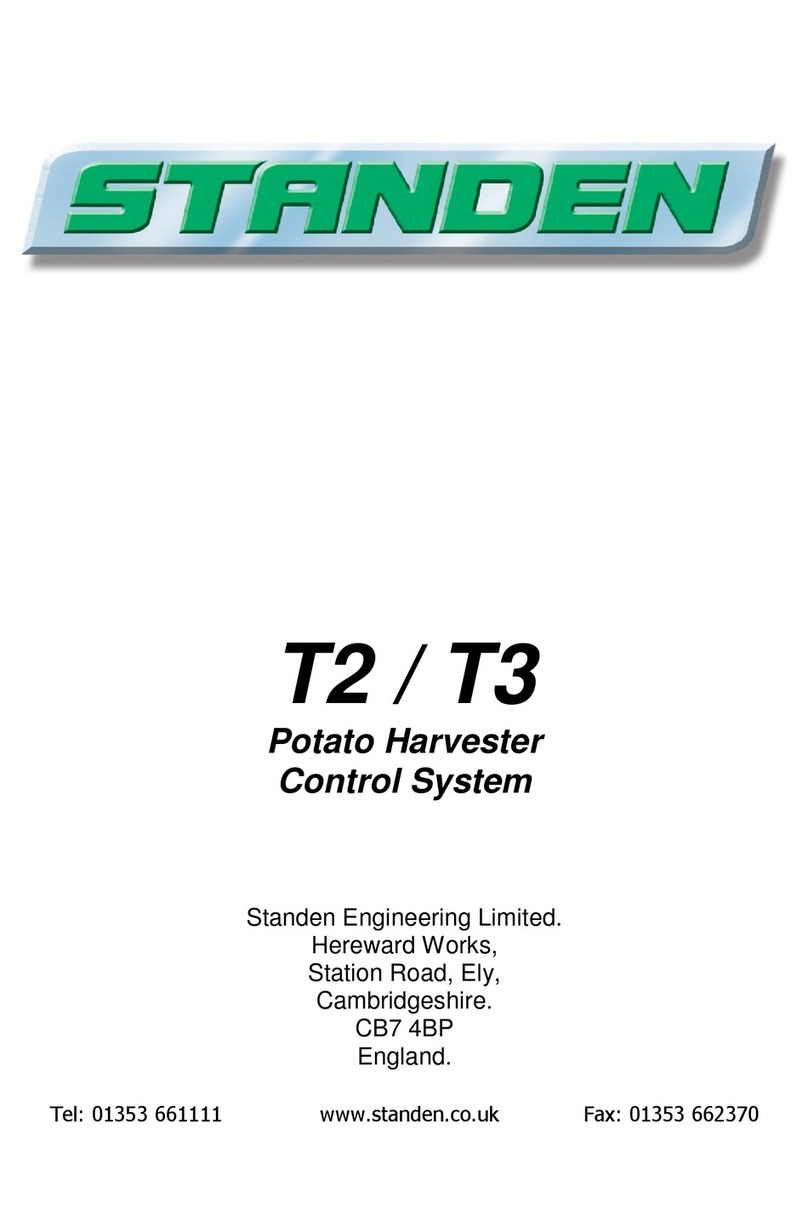
Standen
Standen T2 Service manual

Standen
Standen SP Series User manual

Standen
Standen ZENO Series User manual

Standen
Standen T2 User manual
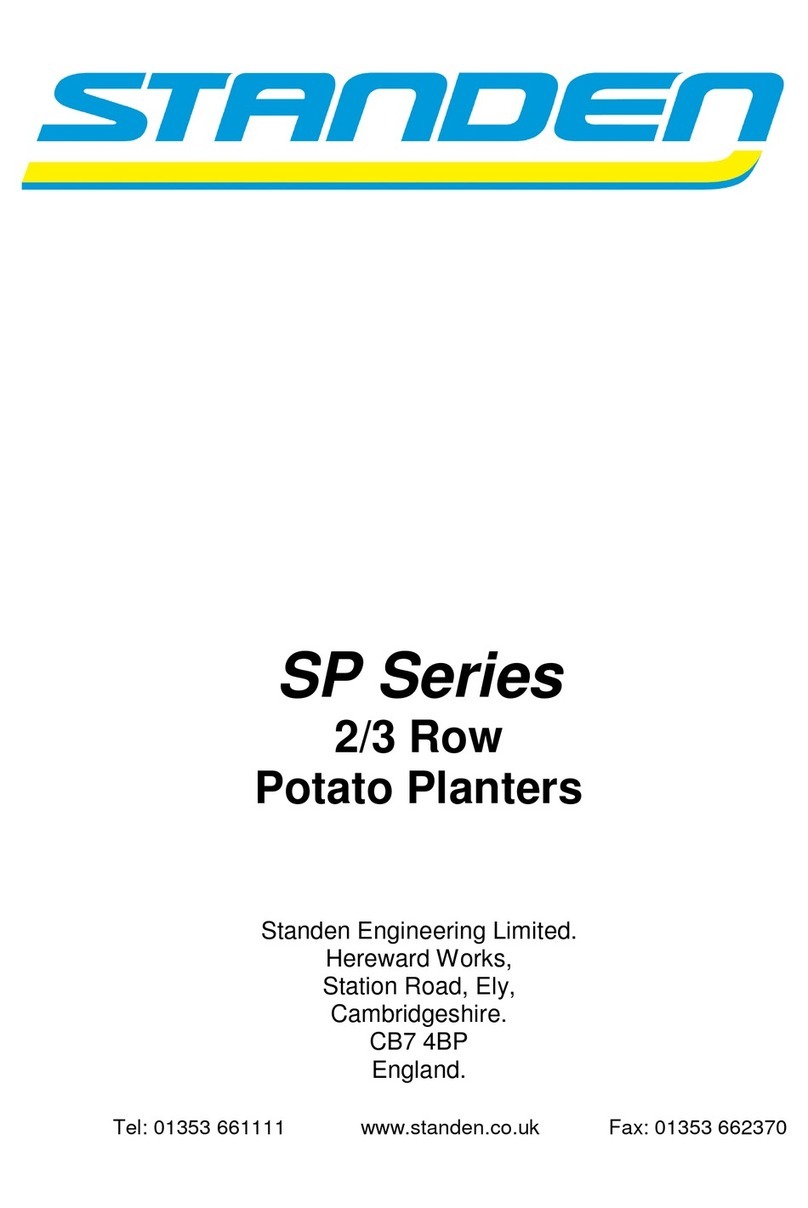
Standen
Standen SP Series User manual
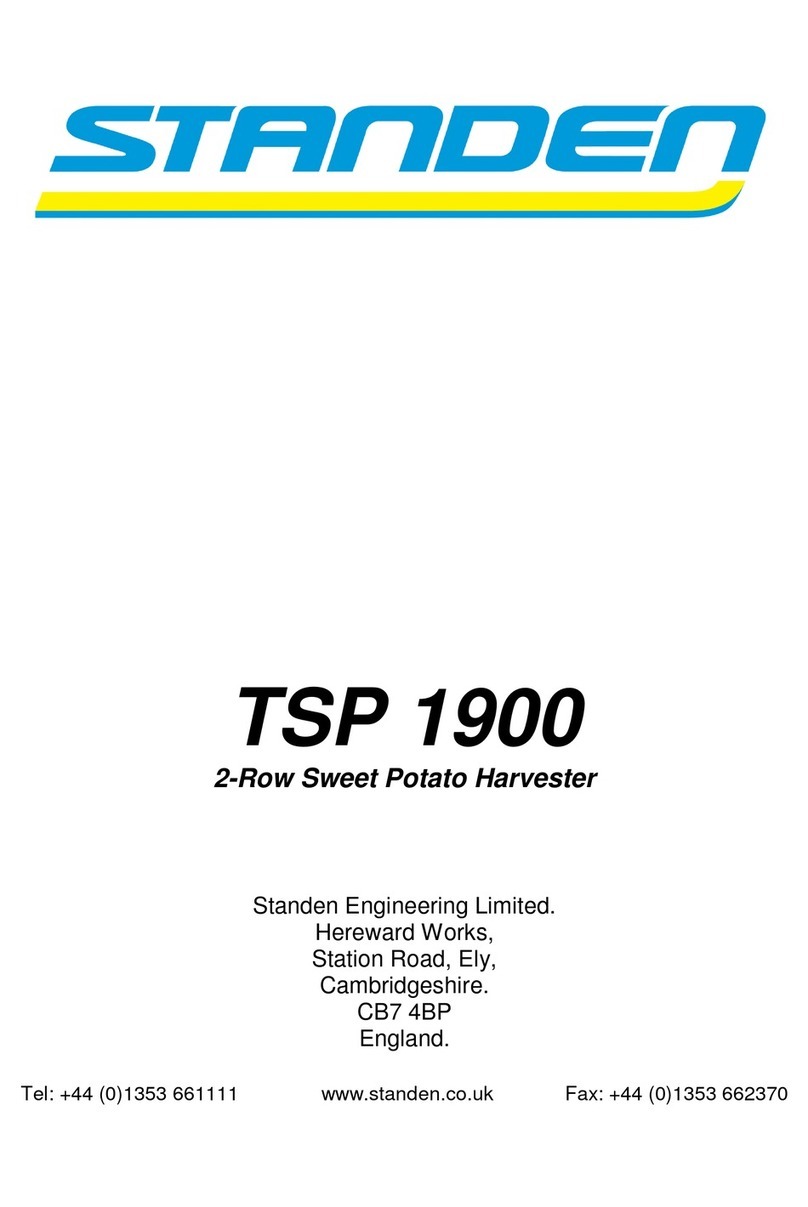
Standen
Standen TSP 1900 Service manual
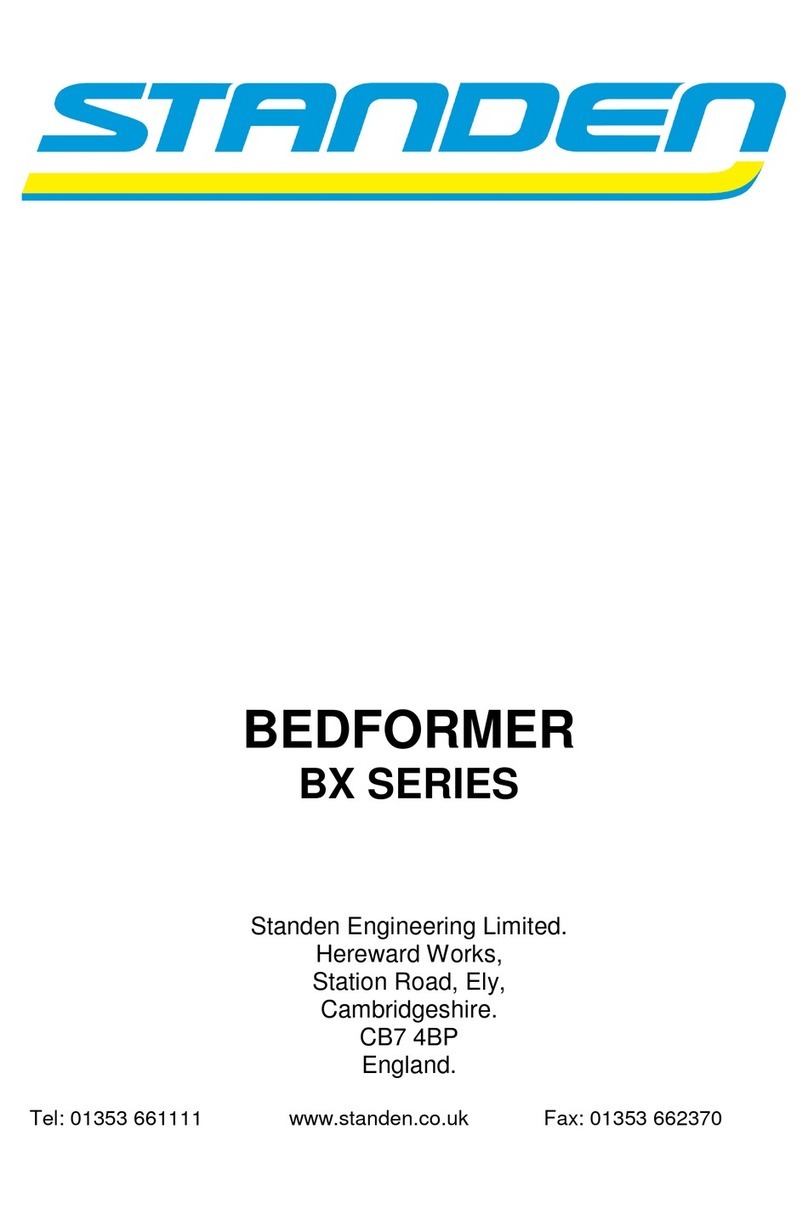
Standen
Standen BX Series User manual

Standen
Standen POWAVATOR 400 User manual

Standen
Standen SP Series User manual

